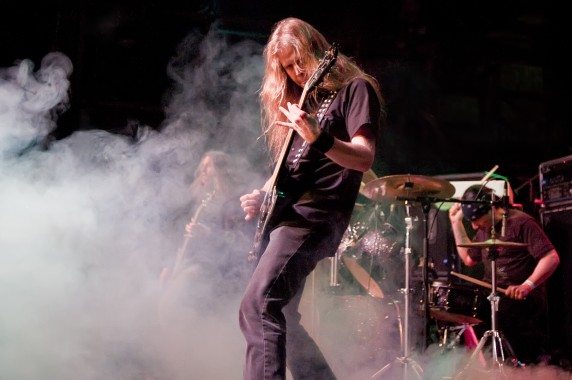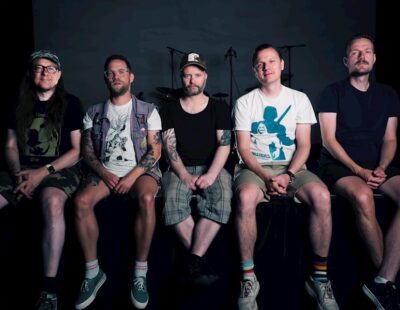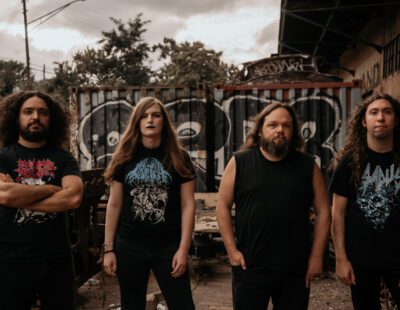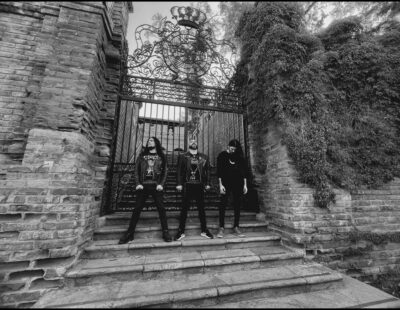Spare a thought for all those hardy underground searchlights who’d been holding their breath waiting for Oakland, CA power-trio Brainoil to follow up the riff ‘n’ tumble of 2003’s superlative self-titled debut. They will have been dead and buried now, asphyxiated, gone purple in the cheek from the eight-year stretch when bassist/vocalist Greg Wilkinson, guitarist/vocalist Nathan Smith and sticksman Ira Harris busied themselves in various projects in the Bay Area’s crust/hardcore/metal/Other scenes.Wilkinson was busy opening up his own studio, Earhammer—where appropriately, Death of This Dry Season was recorded—and playing in doom-drone sludge titans Laudanum. Smith was in crust champs Stormcrow. While the success of Watch Them Die meant that Harris was spending most of his time travelling in a van. But fucking credit to these dudes for sticking with the original gameplan and preserving The Project, viz. Brainoil, holding over the song ideas and waiting until the planets aligned and they could do this again.
It’s weird, though, because for all the merits of their other projects, Brainoil is right up near the top on the Most Crucial Index of Quality. They’ve been bracketed as sludge, and sure when the screams hit some of the more morose riffs that’d kind of be appropriate—they’ve played shows with Eyehategod, too. But there’s a crusty hardcore brevity and intensity to a lot of their jams, not to mention some metal too, that makes sludge a poor fit. In short: they’re for all you riff-dependent no-gooders, the wastoids, the sort of cats who grill minute steaks on the hot tubes of large guitar amplifiers, those of you who don’t mind a crossover of genres so long as the delivery is so targeted, so concise. The songwriting is so white-knuckle and supertight on Death of This Dry Season that if any of the aforementioned Decibel demographics slept-on this album it would be a crime beyond compare. Anyway, here’s Brainoil: this is (more or less) their story so far.
Why did it take so long to put out a second album?
Greg Wilkinson: Well I think it was a combination of things, everybody had different bands going on, different projects, everyone was doing their albums and touring and that was definitely a major factor.
Nathan Smith: “Yeah, that’s an interesting convergence of a few different things. Ira, of course, was doing Watch Them Die at the time, and that band became really active—I’ll let him talk about that. Greg was building a recording studio at about the time Brainoil began to disappear, and I had become active with a different band called Stormcrow. So we all kinda got busy doing our own separate projects but never let Brainoil die completely, there was only a few years where we only rehearsed half-a-dozen times, two/three times and we kept some song ideas together but weren’t super-active in playing shows.”
GW: “I think 2007 was the only year that we didn’t actually play a show locally.
NS: “Do you wanna say a few words about Watch Them Die, Ira, and what was going on with that? I mean that was a pretty serious project.”
Ira Harris: “Yeah, I guess at the time we started touring, then we starting touring more and more and I was away more than I was at home, so it was pretty hard to play with these guys at the time. I had to put it on the backburner—sorry guys! ”
A lot of people might have let the band die. Was there always the intention to go back to Brainoil?
NS: “Yeah, I think so. We never really wanted the project or the idea to die completely, and I think that, as far as switching members, I never really wanted the band to deteriorate to the point where we’d seriously consider replacing people: I’d rather have the band go to sleep for a while and continue to go on with Greg and Ira as the two other people in the band in case of replacing the drummer or something like that. I think there’s a pretty unique sound brought to the band that would be tough to replace.”
GW: “I think Brainoil is its own monster. Some bands don’t work that way, but in this band I think everybody has a lot of weight to their input to the band, and by changing members that would change, drastically, the sound of the band which then wouldn’t be Brainoil any more. I agree with Nate on that. It would change the sound too much to go on.”
Is it easier to hold together a trio? Even though you’ve been on hiatus you seem incredibly together.
NS: “It’s a lot easier than some of the other projects I’ve been involved in, just because the more people you have involved the more chance there is of something going off the rails, or one person wants to stand up too much when there are other people in the room. It’s like trying to hold a marriage together with like five people—it just gets crazy. Three people, it’s a lot easier to compromise as long as you don’t have one person dominating everything.”
IH: “It’s easier to keep everything in check if it’s three people.”
GW: “Yeah, everything has to be unanimous or majority rules, and when there’s only three people there’s never a 50:50 split on anything.”
Would you consider yourself a sludge band?
NS: “Yeah I think that was a term that was applied to us rather than us consciously picking the term. I don’t think that—speaking for myself, but I think Greg and I already agreed upon it—it’s my favourite term but I don’t actually hate it. I think that’s how we get termed and lumped into that particular category by your average internet site that’s categorising heavy music.”
GW: “It doesn’t necessarily encompass exactly what us as a band sounds like, it’s just the most familiar go-to term that might grab someone’s opinion or turn someone on to what we sound like—it’s a good shortcut, right!?”
NS: “There’s a whole hardcore/punk rock ethic to the things that we do and I think that term downplays that side of it, and I think that is what’s missing when simply using the term sludge.”
What was the musical ethos behind Brainoil when you started and has it changed now?
GW: “It’s really a hodgepotch of various styles and sludge is the closest filter. But it goes all the way back to prog and experimental rock, early metal, punk and hardcore, definitely the whole convergence of the three people coming together and interpreting the riff. There’s times where I feel like coming to practice with a Rudimentary Peni sort of riff and then it gets thrown through the filter and comes out sounding like Brainoil. The mentality probably changes from song to song, in terms of the songwriting, at least for myself.”
IH: “Oh definitely. Definitely. Everything is different; a couple of songs sound punk to me, at least they’re a little faster, and some songs sound like they should be slow and heavy; it’s just about how it feels when we are playing it rather than what we are trying to accomplish in making the song.”
GW: “I think the general overall concept to our sound and songwriting at least is to try to not overdevelop a song idea, to develop a song and not let it go too long or far, just get the idea developed and finished and that’s probably the strongest mentality in our songwriting and sound.”
NS: “That’s a really good point. The way that Brainoil songs seem to come together is that they are based around one or two or three really filtered and interesting, and excellent riffs with great time signatures. But not like something like traditional doom metal or quote/unquote stoner rock; we’re not going to ride that riff for ten, fifteen minutes or even seven, eight minutes: you’ll find a lot of our songs in the two to three-and-a-half minute range so it’s almost like a punk rock/grindcore or sometimes even like a powerviolence mentality in the way that the songs are structured, it’s real focused on a few really good ideas but not riding them so long that you start to get bored with it.”
GW: “Yeah, I think that the time signature thing is another interesting point. I think early on—and it’s just become part of our style—was to try not to write in a 4/4 time signature, but to try keep it sounding like a 4/4, to keep it more accessible sounding without actually…. ‘Cos there’s two different directions you can go with the time signatures; you can go like prog music and jam out on some weird crazy stuff and people are just oogling over what you’re doing and saying ‘Wow, check out what the guitar/bass player or the drummer is doing, that’s some crazy stuff’ or you could try make it 4/4 so you’re not losing the groove to it. That’s definitely another fundamental thing that we like to do—not necessarily avoid 4/4 but try to avoid doing it all 4/4 throughout the whole record. That starts to create a stoner rock kind of feel to the music that we are trying to do. It’s not really what we’re shooting for.”
It’s hard to nod your head to a 5/4. For most audiences, 4/4 is hard enough.
NS: “I think that we have an odd time signature here and there, kinda non-traditional, kinda what Greg’s saying is that make it accessible sounding, make it in a way that people can groove to and bang their head to it but not be completely predictable as to where the next beat is going to come from—that’s the twist on it.”
GW: “Yeah, keep it interesting but not turn it into a guitar lesson. Keep it so that it’s still a fun time for everyone, you’re including everyone in the room at the same time.”
Is the Bay Area still a great place to make music? Is it still easy to do what you want?
IH: “I think it is easy to do what you want but I think it is hard to find people of like minds to jam with who are in it for the long-term commitment and that’s one of the things that I really like about Brainoil—‘cos you guys are into it. They’re ready to play for however long that we are going to be a band. There is no end in sight.”
NS: “I agree, and the question as to the Bay Area music scene: you can do almost anything that you want because there’s such an interest in people seeking out new and interesting live music, so long as you can put together a show and get some ideas down on paper of songs you want to write, and you’re determined you wanna write, the people are around. You can put together more music that’s unique and diverse than any other area that I have lived in. I only transplanted here for the last fifteen years or so but I think the diversity of the Bay Area music scene far surpasses anything that I’ve seen anywhere else, on the East Coast or Minneapolis, which are my two main comparisons.”

How old are the songs on the new album?
GW: “I’d say two of them have been around for six, seven years.”
NS: “Yeah, there’s one in particular—”Feet Cling to the Rotting Soil”—which has been around for definitely been around… It’s hard to say but a lot of people who’ve reviewed the album and heard it have enjoyed that quite a bit. ‘Cos I was kinda worried about that song, because having been around for so long, having played it so long, you don’t want it to sound burned out. You can tell if the band is tired of playing it. It was nice to put it down for a while. Some parts of it got slightly reinvented in a good way, especially with how the vocals were done. That’s an example of one of the older songs, but “Crimson Shadows” and “Opaque Reflections” are probably the newest ones on the record.”
GW: “Those are the newest ones, and then I think “Gravity is a Relic” is probably a couple of years old. And also “the Beauty of Death” is two or three years old as well. It’s kind been slowly trickling over time. It’s a bit of us then and us now put together on this one record.”
Is there any sort of theme to it, lyrically?
GW: “I’d say it’s more personal.
NS: “Yeah, songs like “Crimson Shadows” are really deeply personal to me, with some of the stuff it felt like I was mentally struggling with at points during last year. I don’t write that many lyrics but the ones that I do—like on Opaque Reflections, that was as political as I’ve been in recent years and takes in some of the recent economic situation round the world—but the majority are from a personal life-experience perspective. Like, what do you think, Greg? Death of the Dry Season, what was the inspiration for that? That song creates a really interesting picture; that’s why I think it was an excellent choice for the [album] title.”
GW: “That was actually more of a personal slant as well. That one being one of the oldest songs we had was kind of a good bridge from the last record to this record. It was more of a personal content, it is just about looking at the face of hopelessness and then finding hope at the end, in a very brief synopsis as to what it’s about. It kinda describes the fact that we didn’t put out a record for eight years and then came out with one.”
NS: “Yeah, people were maybe a little surprised. I remember being on tour with my previous band, Stormcrow, and I was in Seattle for the second time in about two or three years and this one guy asked me about Brainoil. I was telling him about how we were still writing songs, still an active band and we were recording an album, and he totally busted me and said, ‘You told me that the last time I saw you—I don’t think it’s ever going to happen!’ I felt so bad, I felt like he’d totally called my bluff. Maybe I’ll see him in the next couple of years and can have a laugh with him.”
GW: “With Laudanum I had the same issues, people would be like, ‘Oh Brainoil, I thought you broke up.’ No, it’s been a long time, that’s all.”
NS: “I think until we did a record, there was a serious contingent who were never going to believe us.”
The super-gnarly “Inquisition” from Brainoil’s self-titled debut (2003)
After all this time out, was it easy to record?
NS: “Greg owns a studio and this was the first time we got to record there. In that respect, it was one of the most relaxed sessions we could have done, we could really take our time with some of the parts that might get rushed if we had to go somewhere and pay a significantly greater amount of money on someone else’s schedule.”
IH: “It’s definitely more relaxing being able to record in Greg’s studio, and being able to take our time to sound exactly the way we wanted to without having to compromise.”
GW: “Yeah, no shotgun sessions!”
Are you going to tour it?
NS: “With our work schedules it’s hard for us to do anything outside of short, brief tours near to the San Francisco Bay Area. Unfortunately, we have pretty tough daytime schedules and it’s tough for us to tour.”
GW: “We’ll probably do little legs here and there but we can’t do long ones, unfortunately.”
How did the artwork come about?
GW: “That was done by some friends of ours, they’re a collective called the Feeding, John from Iron Lung is one of the two people and basically, yeah, we gave him the tunes and said take it where it goes and that’s what they came up with. They ended up doing a 24 x 24-inch poster, front and back panel inserts. The Feeding actually has artwork as well, they have a MySpace, if you look up the Feeding you can find a bunch of their art there.”
What projects do you have on the go at the moment?
GW: “That’s an interesting question. I think we pretty much are all down to Brainoil at this point.”
NS: “For me it’s just Brainoil as well. I’ve tried, in the years past I’ve tried to juggle a few bands all at once and I think I’ve learned my lesson. I want to do one thing and put my energy in one place or else I think I’ll get spread too thin so Brainoil is my primary focus.”
GW: “If you had a time machine and you asked that question about two years ago I’d have listed about seven or nine bands.”
NS: “It’s very unusual that Greg can only say one band, and for good reason too; he’s usually got a whole bunch of good ideas going on. You’ve caught him at a quiet moment.”
GW: “The studio takes up all my free time.”






